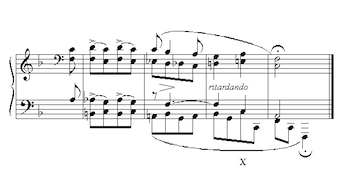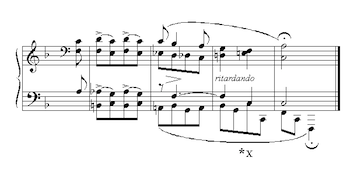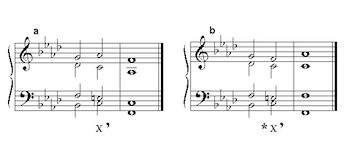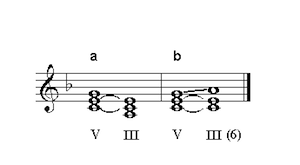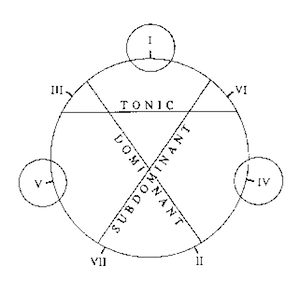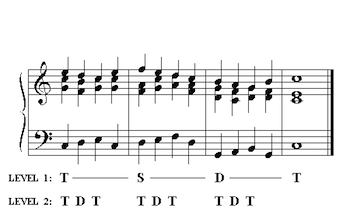Conventional Harmonic Wisdom and the Scope of Schenkerian Theory: A Reply to John Rothgeb
Eytan Agmon
KEYWORDS: functional harmony, Riemann, Schenker, context, Stufe, Auskomponierung, Ursatz
ABSTRACT: The essay consists of three parts. (1) A response to John Rothgeb’s objections to the modified version of Riemann’s functional harmonic theory proposed in Eytan Agmon’s Music Theory Spectrum article, “Functional Harmony Revisited.” (2) A discussion of the conflict between the type of “conventional harmonic wisdom” that (modified) functionalism represents and Schenker’s view of tonality. (3) A discussion of what this conflict implies as far as the scope of Schenkerian theory is concerned.
Copyright © 1996 Society for Music Theory
I
[1] In “Functional Harmony Revisited: A Prototype- Theoretic Approach” (henceforth, FHR), I have proposed a modified version of Hugo Riemann’s functional harmonic theory.(1) John Rothgeb, in a recent MTO contribution, objects to the (modified) theory on two main counts. First, given an approach to tonal pitch-structure (such as Heinrich Schenker’s) that emphasizes context in general and voice leading in particular, (modified) functionalism is superfluous or trivial at best, if not downright pernicious; second, the theory leads to a deplorable intellectual regression, since it negates such remarkable theoretical achievements as Schenker’s notions of “scale-step” (Stufe) and “composing-out” (Auskomponierung).(2)
[2] I shall begin the present essay by responding to Rothgeb’s objections; neither, I hope to demonstrate, stands up under scrutiny. However, I believe that Rothgeb is nonetheless correct in sensing that a serious conflict indeed exists between “conventional [harmonic] wisdom,” of which functionalism is apparently an important ingredient, and certain tenets of Schenker’s theory.(3) In the second part of this essay, therefore, I shall attempt to isolate the source of this conflict; I shall conclude the essay by considering the conflict’s implications as far as the scope of Schenkerian theory is concerned.(4)
Example 1. Schumann, “Am Kamin,” mm. 29–32
(click to enlarge and listen)
Example 2. “Am Kamin,” recomposed
(click to enlarge and listen)
Example 3. a) The “Am Kamin” cadence, transposed to minor; b) recomposition of a
(click to enlarge)
[3] Rothgeb purports to establish the superfluousness of functional theory, vis a vis an approach that emphasizes context and voice leading, by analyzing the concluding bars of Schumann’s “Am Kamin” from Kinderszenen (see Example 1); he concentrates in particular on the “vertical event” marked “X.” For present purposes, Rothgeb’s argument may be reduced to three essential claims: “strong horizontalism,” “weak horizontalism,” and “contextualism.”
[4] Strong horizontalism. According to strong
horizontalism, X is a more-or-less accidental result of
linear motion; in particular, the note a “
[5] For all that Schenker would have us believe that linear motion in tonal music—apparently by some divine miracle—tends to yield precisely triads and seventh chords as vertical sonorities, strong horizontalism is a patently absurd position. In Example 2 Schumann’s X is replaced by an impostor vertical event *X (Schumann’s concluding tonic is also slightly altered in the example: it now features 3 in the soprano rather than 1). In voice-leading terms, X and *X are exactly analogous (the f in *X is also an escape tone or anticipation of the coming tonic harmony); yet *X is plainly unacceptable.
[6] In view of Example 2 one might concede that X is not
totally unconstrained as a vertical event (although it
nonetheless falls short of being a triad); X, one might
propose, is consonant. However, Example 3a, where
Schumann’s cadence is transposed to minor, exposes the
uselessness of such a move. The relationship between X’
and *X’ in Examples 3a and 3b is exactly analogous to the
relationship between X and *X in Examples 1 and 2, even though
X’ is dissonant. Moreover, when it comes to seventh
chords, the consonance criterion must in any event be
abandoned. In paragraph 8 Rothgeb explains “the origin of
Schumann’s ![]()
[7] Once one concedes that X is a triad (rather than some accidental collection of pitches), one must also concede that X is an a-minor triad in first inversion, that is, a III6 chord. To be sure, the function of X is not specified by the III6 label; the purpose of (modified) functionalism is precisely to fill-in this theoretical void. According to (modified) functionalism, X “has dominant function”; X, in other words, is a member of a set of triads—a category—whose prototype is V. The relationship between X and V, moreover, is one of maximal similarity, that is, the two triads have two tones in common.
[8] As it happens, Rothgeb also sees a relationship between X and a hypothetical V: “people who hear musically will have a strong predilection to hear this final [falling] fifth [in the bass] as representing V–I even though its penultimate member does not bear the 5/3 sonority which alone would provide full congruence between scale-degree meaning and vertical chord” (paragraph 8). Indeed, given this statement (together with Rothgeb’s earlier concession that I, IV, and V “are indeed primary in some meaningful sense”), one begins to wonder what the dispute is all about. Nonetheless, from his discussion of the IV/II relationship (see especially paragraph 8, as well as paragraph 16 and n. 14), one suspects that Rothgeb would object to seeing the V/III relationship in terms of common tones; rather, for Rothgeb the V/III relationship is once again a matter of voice leading.
Example 4. The V/III relationship: a) according to functionalism; b) according to weak horizontalism
(click to enlarge)
Example 5. Fig. 2 from Eytan Agmon, “Linear Transformations Between Cyclically Generated Chords” (Musikometrika 3, 1991)
(click to enlarge)
[9] Weak horizontalism. Weak horizontalism concedes that
X is a triad (thus X is a
[10] Unlike strong horizontalism, weak horizontalism is by no means an absurd position. Indeed, it appears that no convincing counter-argument to weak horizontalism existed prior to my 1991 paper entitled “Linear Transformations Between Cyclically Generated Chords,” where it was pointed out that our ability to describe chordal relationships in tonal music both “harmonically” and “linearly”—as in Example 4—cannot be taken for granted.(5) For example, within a 7-note cyclic set the triad and seventh chord are the only generated chords that form linear connections in any pairwise combination (that is, any triad or seventh chord can connect linearly to any other triad or seventh chord), assuming that the linear connections satisfy a certain “efficiency” constraint. The essential idea involved is illustrated (for triads only) in Example 5. The article mentioned proceeds to propose definitions for “triad” and “seventh chord” based on this linear criterion.
[11] Once “triad” and “seventh chord” are defined on the
basis of voice-leading considerations, the pernicious
harmony/voice-leading dichotomy loses much of its force.
In particular, to say that III is related to V by virtue
of two common tones, and to say that
[12] Contextualism. One may agree that X is a
[13] The doctrine of contextualism is with us at least since 1934, when Oswald Jonas has stated that functionalism “had to fail, because it neglected the fact that two occurrences of the same chord could be worlds apart in meaning, and that everything depended on context.”(7) Rothgeb echoes the idea in paragraph 9 of his commentary:
When I say that in this case [i.e., Schumann’s “Am Kamin”] “III” means V, the word means may be explicated as “constitutes, or is included within, a harmonic expression of.” “III” may equally mean I; “II” may mean IV; indeed, instances of “X” meaning Y are legion in the repertoire of tonal music, and virtually no a-priori limits can be set on the ranges of “X” and “Y”.(8)
[14] Although Rothgeb concedes in a footnote that “certain limits would probably stand up under scrutiny,” his statement is surely a gross misrepresentation of musical reality. Can “III” mean IV? Can “II” mean I? Can “IV” mean V? In fact, the examples of “X meaning Y” that Rothgeb cites are exactly those which functional theory allows.
[15] Since Rothgeb proceeds in the next paragraph to consider Schenker’s notion of “scale-step,” I suspect that when he speaks of no a-priori constraints on “X meaning Y” he has in mind hierarchical subordination rather than functional significance. In Schenker’s theory, III (for example) may participate in prolonging IV, as IV may participate in prolonging V. And indeed, when it comes to hierarchy, functionalism seems to suffer badly in comparison to Schenker’s theory, which introduced the profound idea of structural levels (recursive embedding) to tonal theory. However, in FHR I have claimed that (modified) functionalism “is compatible with a hierarchical approach” (page 203); I should now like to make good this claim.
Figure 1
(click to enlarge and see the rest)
Example 6. After Carl Schachter, “Analysis by Key: Another Look at Modulation” (Music Analysis 6:3, 1987), Example 3
(click to enlarge)
[16] Functional Auskomponierung.(9) Figure 1a reproduces Figure 2c from FHR. Note that the figure is drawn from the vantage point of the tonic triad, whose referential status is assumed a priori. This means that Figure 1a would generate—in conjunction with a theory of chord progression—functionally interpreted progressions that prolong I (e.g., I–IV–V–I), and only I; thus Figure 1a may be termed a I-Stufe functional diagram.
[17] Figure 1a may be analyzed in terms of two independent components: a circle of third-related triads, and a “functional grid” by which the seven triads are divided into three categories, and where, for each category, a specific triad is selected as prototype. Suppose now that one rotates the circle of triads in Figure 1a—but not the underlying functional grid!—in such a way that V occupies the former position of I (Figure 1b); we now have a V-Stufe functional diagram. In conjunction with the same theory of chord progression, Figure 1b generates functionally interpreted progressions that prolong V, e.g. V–I–V (T–S–T), V–IV–V (T–D–T), V–II–V (T–D–T), etc. In a similar fashion, any of the seven harmonic degrees may assume a Stufe role. To create a functional hierarchy one begins by generating a I-Stufe progression (say, I–II–V–I) at the highest level. One then selects any harmonic degree from this progression—say, II—as a lower-level Stufe, and (using the appropriate functional diagram) generates a hierarchically subordinate, functionally interpreted progression (say, II–I–II); in a recursive fashion, one may create functionally interpreted progressions embedded to any arbitrary hierarchical depth.
[18] Example 6 illustrates a typical progression generated by the theory of functional Auskomponierung. Carl Schachter, who invented the progression, views the II and V chords in measures 2–3 as prolonged or composed-out (Auskomponiert) entities.(10) It is important to realize that even though voice leading plays a crucial role in the Auskomponierung process (note the voice exchanges), other factors (such as rhythm and meter) are equally involved. In FHR I have drawn a clear distinction between the functional potential of a given triad, which is given a priori, and the realization of that potential, which is context-dependent (page 206). For example, the potential of I to assume dominant function in a II-Stufe progression (such as II–I–II) is given a-priori in (modified) functional theory; to bring this potential into musical fruition, however, may require a coordination among several compositional variables, as Example 6 illustrates. Schenker has made a lasting contribution to tonal theory in emphasizing the crucial contextual role of voice leading. However, Schenker also believed that voice leading can be promoted above and beyond any other principle as the basis for a theory of tonal structure; this latter belief is the source of some serious conflicts with the type of “conventional harmonic wisdom” that (modified) functionalism represents.
II
[19] In the preceding section I have presented arguments which I believe set to rest Rothgeb’s objections to (modified) functionalism. In particular, strong horizontalism, weak horizontalism, and contextualism have been shown to be either plainly unacceptable or irrelevant doctrines, which leaves Rothgeb’s claims concerning the superfluousness of (modified) functionalism without support. Moreover, the idea of functional Auskomponierung renders Rothgeb’s complaint concerning the intellectual poverty of functionalism (relative to Schenker’s theory) no longer valid. Indeed, (modified) functionalism agrees with the Schenkerian approach on two important points: (1) tonal pitch structure is hierarchical in nature; (2) voice leading plays a crucial role in rendering the assumed hierarchy cognitively accessible. Nonetheless, it would be wrong to pretend that a serious conflict between the two theories does not exist. In the present section I should like to isolate the source of this conflict.
[20] For Schenker, all tonal structure is ultimately referable to the Ursatz a theoretic construct whose rationale is essentially linear-contrapuntal: a dissonant passing-tone in the top voice is rendered consonant by means of a bass-arpeggiation. How does the Ursatz conflict with conventional harmonic wisdom? One conflict is immediately apparent. As far as the Ursatz is concerned, there are only two basic harmonic states, “tonic” and “dominant”; a third harmonic state (say, “subdominant”) does not exist, or if it does, its status within the tonal hierarchy is, by definition, inferior.
[21] Even in terms of Schenker’s own theory, the idea that
IV or II6 represent some sort of “leaping passing-tone”
configuration in the bass surely leaves much to be
desired. Moreover, Schenker’s account forces an
uncomfortable analogy between the functions of IV and
[22] Schenker’s Ursatz is at odds with conventional
harmonic wisdom not only concerning the status of the
subdominant; an even more severe conflict, I believe,
concerns the dominant. By conventional harmonic wisdom, I–![]()
III
[23] Lest I should be once again accused of inciting intellectual regress, let me hasten to point out that my critique of Schenker’s Ursatz applies only in so far as the construct is claimed to constitute a theory of tonality, a theory by which conventional harmonic wisdom is condescendingly dismissed. I have no objection whatsoever to a more limited interpretation of what the Ursatz stands for, for example, that the Ursatz (or some Ursatz-like configuration) is an analytic construct, hypothesized to describe the structure of some specific piece of music (or possibly a group of pieces); as such, the Ursatz may be seen as a contextualized harmonic progression, situated at some (possibly deep) level of compositional structure. Indeed, as a contextualized I–V–I progression Schenker’s Ursatz makes much compositional sense, for it lends the progression, from the linear point of view, a clear sense of purpose and direction.
[24] I am well aware that for some readers, giving up Schenker’s grand vision of tonality as an unfolding in time of the Chord of Nature may seem an exceedingly dear price to pay. But I also believe that for many others, who—like myself—deeply cherish the analytic insights that Schenker’s approach has to offer, and yet are unable to turn their backs on conventional harmonic wisdom, there is simply no other choice. As someone whose involvement with the Schenkerian approach over the years has been more than casual, I know how difficult it can be to admit that Schenker delivers less than he promises. Nonetheless, I believe it is essential that the scope of Schenkerian theory be seriously reassessed. For if, as Rothgeb would have us believe, there is simply no way in which the ideas of Heinrich Schenker and Hugo Riemann may be reconciled, tonal theory is a very small town indeed.
Eytan Agmon
Bar-Ilan University
Department of Musicology
52900 Ramat-Gan
Israel
agmone@ashur.cc.biu.ac.il
Footnotes
1. Music Theory Spectrum 17:2 (1995), 196–214.
Return to text
2. John Rothgeb, “Re: Eytan Agmon on Functional Theory,”
Music Theory Online 2.1 (1996).
Return to text
3. The expression “conventional [harmonic] wisdom”
appears in n. 12 of Rothgeb’s commentary. The
condescending tone in which this expression is used recurs
in Rothgeb’s reference to “the language of the completely
conventional harmony textbook” in paragraph 11, and his
reference to “most undergraduate students” in paragraph 14.
Return to text
4. At least two of Rothgeb’s grievances seem to reflect
plain miscomprehension of my text. His discussion in
paragraphs 14–15 of “II as IV” is totally beside the point
in view of the category/chord distinction on which
modified functionalism so crucially depends (see
especially FHR, page 204). Similarly, one of Rothgeb’s
central lines of attack on FHR, concerning the role of
context in harmonic theory (of which more shall be said
subsequently), seems oblivious of the important
distinction on page 206 between the functional potential
of a given chord, which the theory proposed in FHR sets
out to describe, and the realization of that potential in
context (which, strictly speaking, lies outside the scope
of the proposed theory). To be sure, for someone who does
not believe in harmonic functions in the first place, my
claim that a certain functional potential (specifically,
the subdominant function of VII) can hardly ever be
realized, is an easy target for critique, especially since
that claim is supported in part by an appeal to a
hypothetical theory of chord progression. However, in
terms of discrediting the theory as a whole the effect of
such critique is negligible.
Return to text
5. Eytan Agmon, “Linear Transformations Between
Cyclically Generated Chords,” Musikometrika 3 (1991),
15–40.
Return to text
6. See “Linear Transformations,” pages 22–3. In n. 14
Rothgeb refers to the “equivocality of the ![]()
Return to text
7. Oswald Jonas, Introduction to the Theory of Heinrich
Schenker, trans. and ed. John Rothgeb (New York: Longman,
1982), 127 (emphasis added).
Return to text
8. I have added emphasis to Rothgeb’s “virtually no a-priori limits.”
Return to text
9. Only the bare outlines of the theory are sketched
here; I hope to flesh-out the details in a separate study.
Return to text
10. Carl Schachter, “Analysis by Key: Another Look at
Modulation,” Music Analysis 6:3 (1987), 292. In light of
the present discussion, Auskomponierung may seem to
apply only to functionally interpreted progressions that
begin and end on the same chord (e.g., II–I–II). However,
any functionally interpreted progression referable to a
given scale degree may be said to prolong or compose-
out that degree. For example, I–V–VI, as a I-Stufe
progression, may be said to prolong I.
Return to text
Copyright Statement
Copyright © 1996 by the Society for Music Theory. All rights reserved.
[1] Copyrights for individual items published in Music Theory Online (MTO) are held by their authors. Items appearing in MTO may be saved and stored in electronic or paper form, and may be shared among individuals for purposes of scholarly research or discussion, but may not be republished in any form, electronic or print, without prior, written permission from the author(s), and advance notification of the editors of MTO.
[2] Any redistributed form of items published in MTO must include the following information in a form appropriate to the medium in which the items are to appear:
This item appeared in Music Theory Online in [VOLUME #, ISSUE #] on [DAY/MONTH/YEAR]. It was authored by [FULL NAME, EMAIL ADDRESS], with whose written permission it is reprinted here.
[3] Libraries may archive issues of MTO in electronic or paper form for public access so long as each issue is stored in its entirety, and no access fee is charged. Exceptions to these requirements must be approved in writing by the editors of MTO, who will act in accordance with the decisions of the Society for Music Theory.
This document and all portions thereof are protected by U.S. and international copyright laws. Material contained herein may be copied and/or distributed for research purposes only.
Prepared by Robert Judd, Manager and Tahirih Motazedian, Editorial Assistant

